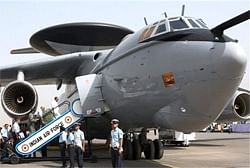
After recurring delays, the Indian Air Force (IAF) on Thursday inducted its first "eye-in-the-sky" airborne warning and control systems (AWACS) which will detect incoming flying weapons and listen-in to aerial communications.
Dedicating the giant IL-76 heavy transport aircraft, configured in its new avatar, to the nation, Defence Minister A.K. Antony expressed his "anxieties" about the other two AWACS being delivered on time.
"The project was signed in 2004... five years is too long a time.... I hope the governments of Russia and Israel and the hard work of our people will help us in getting the other two AWACS on time," Antony said while addressing the gathering, including the Israeli and Russian ambassadors, present during the induction system.
The AWACS project is a tripartite contract between India, Israel and Russia. The $1.1 billion deal for the three AWACS was signed in 2004.
The AWACS flew from Israel to the Jamnagar airbase in Gujarat, escorted by IAF's combat jets.
The AWACS, constituting the number 50 squadron, will be based in Agra.
With the induction of the AWACS, India has joined a club of only six other nations - the US, Russia, Britain, Japan, Australia and Turkey - that operate such a sophisticated system.
Other countries - notably Pakistan, Brazil and Greece - too operate AWACS but at a much lower end of the scale in terms of capability.
With its ability to detect aircraft, cruise missiles and other flying objects at ranges far greater than is possible through existing systems, the AWACS can also collate surface information about troop movements and missile launches even while "listening-in" to highly confidential communications between the enemy's front line units.
To this extent, the AWACS, as a potent force-multiplier, are expected to significantly enhance the effectiveness of the IAF's offensive and defensive operations. Given the intensity and pace of modern-day air warfare, the AWACS will provide an impregnable aerial umbrella to neutralise any incoming threat.